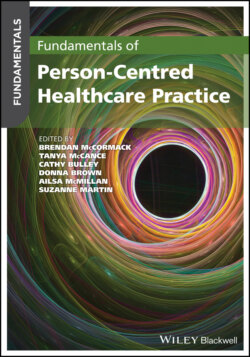Читать книгу Fundamentals of Person-Centred Healthcare Practice - Группа авторов - Страница 69
Understanding and defining self: different perspectives
ОглавлениеIn the Person‐centred Practice Framework, knowing self is defined as the way a person makes sense of their knowing, being and becoming through reflection, self‐awareness and engagement with others. This definition will guide our thinking as we work through this chapter. Within this perspective, self is not viewed as something fixed. As persons, we are on a constant journey of learning to ‘find and re‐fine oneself’ (Dworkin 1991, p. 32). With the goal of self‐development, we engage with lifelong learning and professional growth, through developing self‐awareness and engaging in self‐reflection.
Before exploring why it is important to know self and what the process of knowing self may look like, we need to develop an understanding of what self is. Throughout history, philosophers, psychologists, sociologists and social psychologists have formulated different definitions and theories of self which have resulted in conflicting perspectives about what self is, its nature and the method of investigation. We have here provided a brief summary of the key perspectives on self to encourage exploration of how these may relate to you and the person‐centred perspective. When consulting other texts, you might see slightly different terminology from the one used here.
Experiential perspectives focus on self as an independent and private entity, and on subjective experience. We experience the world and life from a certain point of view, through the lens of our own self. To be a person means to be aware of these experiences (of our thoughts and feelings, for example) and to be aware of being aware. It also means to be able to reflect on our thoughts and actions, to consider different alternatives and the possibility of change. On the other hand, social constructionist perspectives originating from sociology and social sciences view reality and self as socially constructed, as created through the interaction of individuals and groups in the social context. As we grow, social relationships and interactions with others (as well as language and culture) continue to shape who we are and contribute to our ways of thinking and feeling. Furthermore, there are narrative accounts of self, highlighting that selves are agents. Actions take place in time and we can make sense of them when placed within a coherent narrative or life story (temporal and social dimension of self) (Stevens 2002; Zahavi 2014).
There are also realist perspectives of self. These are embraced by various empirical scientists from the areas of psychology, psychiatry and neuroscience, who utilise an experimental approach to the investigation of self, trying to identify measurable variables, to find out the rules that could explain psychological phenomena and the way we behave. As to the biological perspectives of self, these adopt the scientific method to focus on the physiological and genetic processes taking place in the person's body and their influence on behaviour (Stevens 2002; Zahavi 2014).
Some of these perspectives when taken in isolation highlight specific aspects of self, and risk providing a partial and fragmented view. This view clashes with the theory underpinning the Person‐centred Practice Framework and the focus on the person as a whole (encompassing the biological, psychological, social, spiritual and environmental dimensions); on personhood (see Chapter 1); and on the five dimensions of being a person (see Chapter 1). The exploration of the possible interrelationships between different perspectives can help us gain interesting insights into the complexity of self. It also inevitably raises questions about the compatibility, or not, of certain points between the different perspectives which are ultimately related to different ways of viewing reality, what is true and what is real (Stevens 2002; Zahavi 2014).
